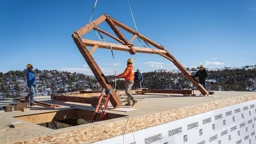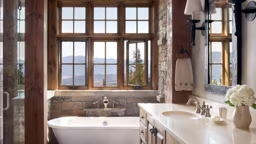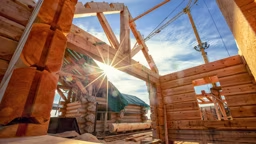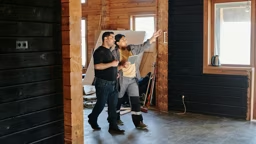
Photo Credit: Canadian Timberframes
With the major structural elements in place at the
Lake of Bays project in Ontario, Canada, it was time to finish out the home’s shell — a process that relied heavily on that all-important element of timing.
“To eliminate material damage or issues onsite, we stay closely connected to the crew, and we schedule deliveries for when the builder is almost ready to walk them into the dried-in shell,” explains
Jeff Bowes, owner of
Canadian Timberframes, the company behind the project. “Once the panels and the roof were in place, the
windows and
doors were delivered; then we got to work on finishing the rest of the house.”
To select the materials for the
exterior of the home, Jeff worked with the owners long before they broke ground, finalizing choices with the help of a sophisticated 3D rendering program. “We have an entire library of finishes in our office, so we can populate each individual drawing accurately, allowing the client to look at the details even closer,” Jeff explains. “This way, you’re not just looking at a tiny sample or color swatch, but a realistic depiction of how the finished house will actually look with those materials in place.”
This type of process is particularly helpful when designing vacation homes, where months can go by without the owners visiting the site. “Our office is in British Columbia, and the house is located clear across the country in Ontario, so this all had to be done remotely,” Jeff adds. “With this type of program, we’re all looking at the same virtual house, no matter where our current location might be.”
Stone & Siding
To achieve the mountain style they were going for, the homeowners chose a native stone for the home’s skirting and exterior columns before sending a sample to Jeff and his design team. To match the stone, Canadian Timberframes sent the owners a box of samples of siding, trim and cedar shakes to choose from.
“We send a wide variety of choices so the homeowners can take a close look, mix and match and take their time making decisions. By the time we do the architectural sign up, they’re not just making choices from pictures,” Jeff says.
The homeowners ultimately went with a pre-stained, kiln-dried western red cedar siding — a rustic-yet-refined choice that complemented the gray tones in the stone. They also opted for a mix of both horizontal and vertical siding.
Windows
As part of the design process, the homeowners also worked with Canadian Timberframes’ in-house window representative to review their options for choosing
windows that would frame the lake views, but not break the bank. “Whenever we’re doing window design, we take the clients’ wishes and populate the design with as many standard windows and doors to make things as economical as possible,” says Jeff. “Because this house sits in a mild climate without extreme temperatures, we could go with mostly standard options in terms of size, shape and thickness.”
Exterior Timber Work
For the exterior
porch ceilings and timber work, everything was factory finished and clear-coated ahead of time, making for a very quick installation. To accommodate the minor marks and blemishes that inevitably occur during construction, extra stain and clear-coat was shipped to the job site so the construction crew could touch up any imperfections, dust or dirt before the house was complete.
In the end, being able to visualize the way the completed house would look long before any stone, siding or other exterior elements were installed proved well worth the added effort. “If you can’t see the finished product ahead of time and something winds up needing to be changed during construction, that’s a pretty expensive ‘oops,’” says Jeff. “A lot of homeowners would just throw their hands up and say, ‘I think I’m going to have to live with it because of the price tag.’ With today’s technology, surprises like that shouldn’t happen.”












